In my classroom-Lecture 13: “Shear strength”
In my classroom – Lecture 13: “Shear strength”
This piece has been commissioned by a colleague of mine for the Civil and Environmental Engineering Department at Duke. The commission has wisely been vague on the subject of the opera, specifying it as „something“. So, here it is: „something“. In such circumstances, understandably, I hope, I spent a few sleepless nights, musing about civil engineering, soaring bridges, high-rise buildings, TV masts, etc. At the end, driven by…. laziness…(which is the most powerful engine of progress), I went back to a drawing I once have sketched for my students to encourage them to be relaxed in class, ask questions, and do whatever their animal instinct directs them to do, including leaving the class, whenever they feel they are not learning new stuff.
 The original drawing for the cutout
The original drawing for the cutout
In doing that, I made a choice, to emphasize the process of teaching and learning rather than the subject of learning, which is the civil and environmental engineering. I thought: there are so many wonderful works showing beautiful bridges, cathedrals, high-rise city sky-line, or individual buildings (and septic tank interiors, I am sure), but are there any depictions of a classroom? Is this, at all, an artistic subject ???
So, the answer is, I think, not very much. With a few very notable exceptions, there is not much on that subject in terms of paintings.
As far as the classroom art, most of that is a medieval art: sculptural reliefs, and illuminated pictures from medieval treaties. Those below, show various takes of classrooms in Bologna, one of the oldest, if not The Oldest European university (other contenders being University of Nalanda (India), Karueein (Morocco), Salerno (It), Salamanca (Sp)), Paris…
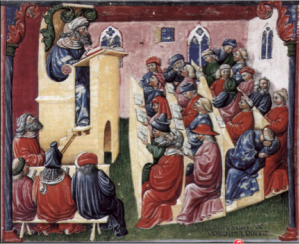 Lecturing at the University of Bologna, Laurentius
Lecturing at the University of Bologna, Laurentius
de Voltolina, 14th c. in German Natl. Museum, Berlin
Bologna 1333, Gianni Dagli Orti—Pinacoteca Nazionale Bologna/The Art Archive
The marble tablet made a huge impression on me some 25 years ago, when it was shown to me by a former doctoral student of mine from Bologna, now a renown professor at Trento, who has been also pointing to me the persistent presence of female students. Is it true? Or we are deceived by the dress, or just by a juvenile face that appears being lady-like. Checking cursorily on the Internet, there is no mention what’s so ever of women attending the universities in 14th century. However, the universities have evolved from a model of 5-9th century monasteries, including those for nuns. The monasteries had as a part of their Regula Magistri the duty of reading and learning, and copying the sacred texts. In the illumination, above, there are other things to note: one student taking a nap, another one (actually two) ogling a female colleague (assuming it’s a female), and a couple engaged in a conversation.
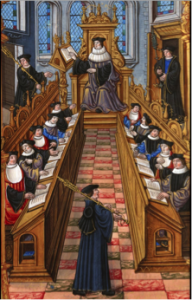 A meeting of doctors at the university of Paris. From the “Chants royaux” manuscript, Bibliothèque Nationale, Paris, 1537
A meeting of doctors at the university of Paris. From the “Chants royaux” manuscript, Bibliothèque Nationale, Paris, 1537
Frankly, I was surprised of the scarcity of paintings of a classroom, of which many of the artists must have had a direct experience. I looked at Cambridge, Oxford, and Harvard sources and found … nothing. There are some 19 century classroom pictures of school kids engaging in prank or being examined, which honestly are not the greatest.
When the Cat’s Away the Mice Will Play; School, Edward Lamson Henry (1841 – 1919, American) Théophile Emmanuel Duverger (1821–1901)
Clearly, the most known depiction of a classroom of sorts is Raffaello Sanzio’s “Scuola di Atene” or “The School of Athens”, a 1509-11 fresco in Vatican Stanza della Segnatura, painted at the order of pope Julius 2nd (Giuliano della Rovere) known as the Terrible Pope, for his bellicose tendencies, but otherwise a great patron of the arts. In this fresco, Raphael represents small groups of the most known Greek (and non-Greek) philosphers and their followers debating between themselves. The original intent of the painter was apparently to depict the capacity of the soul to identify “the goodness”, or “il bene”, or the search for the knowledge of primary causes of everything, with Plato and Aristotle as the central figures. What has been a major entertaining over the centuries since Vasari, is identifying in the images of most of such philosophers the faces of Raphael’s contemporaries, mainly, fellow artists, including himself, twice, (once as Apello, another unknown). By the way, the title itself is a 18th century invention of historians of the epoch, but it easily can be considered as a hyper-school.
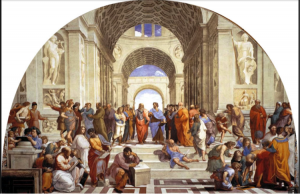 The School of Athens, 1509-1511, by Raffaello Sanzio- in Vatican’s Stanze di Raffaello
The School of Athens, 1509-1511, by Raffaello Sanzio- in Vatican’s Stanze di Raffaello
I was reminded of the Scuola di Atene by my Italian friend, ing. Giorgio Carradori of Bergamo, who suggested that since Raffaello there was little interest in depicting school, classroom, or the process of learning, until now. I appreciate the association, even if tainted with a subtle and joyful irony, as often with Giorgio. So, in fact I did not have in mind the Raphael’s work, but rather was inspired by the genre of painting of Peter (Peasant) Brueghel, the Elder of the type Children’s Game (1570), or Seven Deadly Sins (1558), in which small groups of people (and other creatures) go about their activities (whatever they are), practically not interacting one group with another.
Giorgio, ironically suggested for my cut-out a title “La Nuova Scuola di Atene”. He semi-facetiously (you never know with him) added: If the School of Athens of Raphael symbolized the rationality of research, the New School of Athens represents the complexity of the modern-times science. After having believed that it is able to describe the world with elegant equations, the Science has discovered indeterminism and the role of the randomness. Other scholars have in the meantime realized of the existence of the world of the subconsciousness. The New School of Athens therefore is no more permeated with an olimpic serenity, but with apprehension, which wraps up the today’s world, including that of sciences.
One other citation is that to Diego Velasquez’s Las Meninas, from which I stole the composition: a removed painter (professor) and an assembly of groups of people (of students). Who also got into my picture is the Velasquez’s mysterious person in black in upper right corner door.
The picture, repainted in hundreds versions by Picasso was thence subject of various speculations: who that person was, where the royal couple were?. Only one thing is unchanged: the presence in the back door of the mysterious Don José Nieto Velázquez, likely a relative of Diego, and a Chamberlain of the Queen.
Diego Velasquez, 1556, Las Meninas (Prado, Madrid), also in two versions of Picasso (1957)
In that latest context, one thing I also notice is that times got worse since Raphael and Brueghel and Velasquez (old people always say such things), in that there is really little interaction of anybody with anybody in my cut-out, what I think, instinctively reproduces the reality of today’s classroom. The professor is engaged more with the blackboard that with the class. The students do not interact with professor or their colleagues on science matters, but rather with their laptops or their cell-phones under the table, or exit the class to have a conversation, remotely. Truly, the only two interacting are the two ostriches.
The Rhino is smiling at all students, while the tiger is trying to impress the young lady, that is posing a question. I was asked, why do you have all these animals in the classroom? The answer is not terribly rational: I like them there.
I was asked by an early viewer about the dog peeing in the classroom. This is a very old tradition of painters, especially so called old Dutch Masters. They would have a dog doing his business in….church. Mind, churches in those times were likely the largest buildings in any given town, lot of things would happen there, not necessarily of only religious matter. There hundreds of Flemish paintings showing that. Here are two of circa 1640s by the same painter Hendrick Cornelisz Van Vliet, but showing two different views from the same church, it seems.
Interior of the Nieuwe Kerk at Delft, 1640ca, by Hendrick Cornelisz Van Vliet
Very likely, apart from an element of authenticity, it reflects a sense of distance of the painter toward the main subject of the work. I think it is the same in the current case.
It took me almost half a year to finish this cut-out. First, it came out quite complicated, and second I have been working on two pieces in parallel (the other coming soon). Attached are a few photos of early stages of the work. Note, how things change going from one stage to the next.
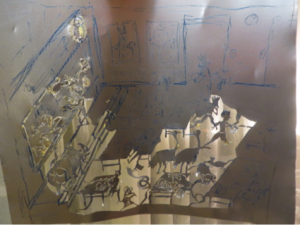
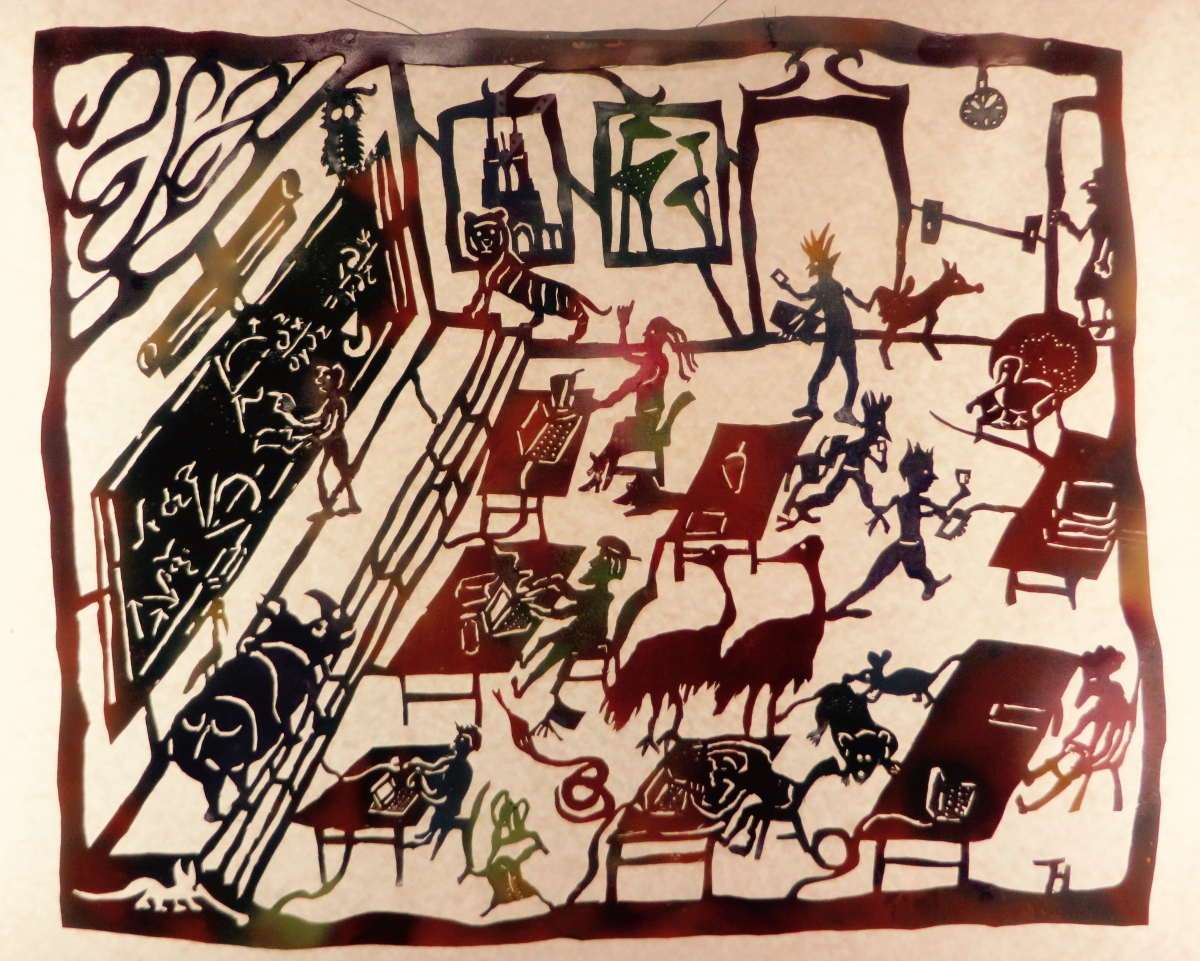




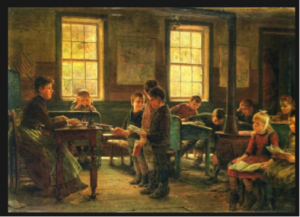
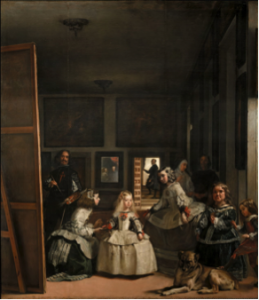
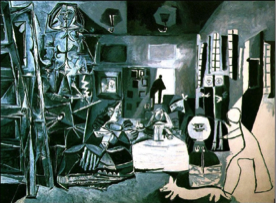
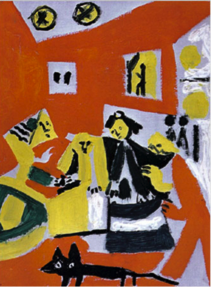


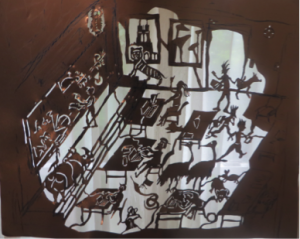
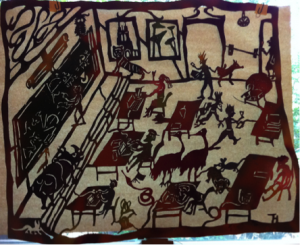
Wow, awesome!! I like it. Is it based on the classroom in Hudson?
Thanks Jun !! Yes, Hudson 125 was on my mind, but it’s more a different classroom in Hudson that doesn’t exist any more, with large drawing tables. A view in the window of Duke Chapel will tell you it’s more fictional…
Congratulations on your artistic achievement Tomasz! I was looking for you in Switzerland but now I know what you have done, instead of being there!